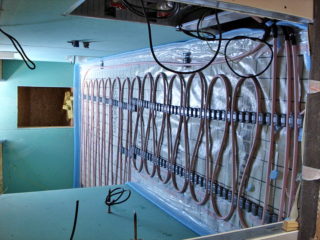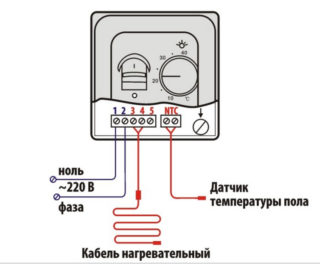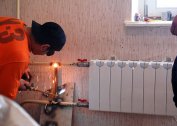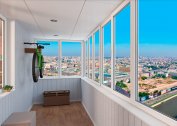Such an installation of a modern heated floor, which works from a standard electric network, is considered a rather original solution when carrying out major repairs in the home. Such a seemingly unexpected decision justifies itself in those cases when the walls of the room need to be insulated, but for some reason it is not possible to produce the classic warming that is usual for everyone.
 To carry out the installation of insulation, the following tools and materials are required:
To carry out the installation of insulation, the following tools and materials are required:
- construction spatula;
- spatula with cloves;
- roller with a pile;
- electric hammer drill;
- construction (installation) knife;
- chisel;
- hammer;
- Means for the destruction of fungus and mold "Neomid" (0.5 kg);
- moisture resistant drywall (thickness - 1cm, area - 4 sq. m);
- insulation for walls with a self-adhesive base "Penoflex" (thickness –0.3 cm, width –1.5 m, length –2.5 m);
- heating mat for the underfloor heating system model Teplolux Mini MN 250 - 1.8, where the heated surface area is 1.8 square meters. m;
- masking tape;
- aluminum tape;
- fasteners (dowel-nails 5x50);
- EC G200 primer based on acrylic (5 liter capacity);
- adhesive for tiles ЕК 3000 (quantity - 25 kg).
After all the materials and equipment have been prepared, you can proceed with the installation work.
Stage One: Preparatory Work
At this stage, preparing the base of the wall before installing the underfloor heating. At this stage, all old wall coverings already existing on the surface are removed to the concrete base of the wall. All bulges must be cleaned, and all chips and cracks should be coated. After this, the contact points of the walls are aligned at right angles. After a while (when the walls are dry), the surfaces must be treated with the Neomid mold and mildew.
Stage Two: Installing the underfloor heating
 At the second stage of installation work, with the help of a construction knife, the necessary size sheets of moisture-proof drywall are cut. Fixing on the wall surface is carried out using dowels. Due to the fact that the walls of the bathroom are made of concrete panels, sheet fasteners should be carried out end-to-end with neighboring mills. Compensatory
At the second stage of installation work, with the help of a construction knife, the necessary size sheets of moisture-proof drywall are cut. Fixing on the wall surface is carried out using dowels. Due to the fact that the walls of the bathroom are made of concrete panels, sheet fasteners should be carried out end-to-end with neighboring mills. Compensatory  the gap in this case does not play a role, and its functions are performed by deviations in the cutting of drywall.
the gap in this case does not play a role, and its functions are performed by deviations in the cutting of drywall.
In accordance with the size of the drywall with the help of scissors, the material for the insulation is cut. A heater with a self-adhesive base is perfect for this, since it is much more convenient to work with it. The insulation is fixed in this way: the protective material is removed from the glue base and fixed with short clips on the surface of the drywall. The joints in the heat-insulating layer are glued with aluminum tape.
Stage Three: Installing Underfloor Heating
The above-mentioned model of a warm floor is quite convenient to install, because it looks like a self-adhesive polymer net with a cable fixed on it, which heats the room. The mesh must be spread over the entire surface, remove the protection from the adhesive base and fix it on the wall. The adhesive base of the heating mat is not designed for vertical fixation, it is for this reason that additional fixation is required using aluminum tape. In accordance with the instructions for installing a warm floor, it is required to prepare special conclusions in order to connect a special sensor and electric power in the future.
Stage Four: Finishing
As a finish finish of the warm floor on the wall, ceramic tiles are laid. In this case, the technique of the operation will not differ in anything from the classic gluing of ceramic tiles to the wall surface.
Step Five: Connect
 After all work related to wall decoration is completed, it is required to connect the heating mat to a special sensor that regulates the functioning of the mat and to the electrical power. When connecting the heating mat, the following operations are required:
After all work related to wall decoration is completed, it is required to connect the heating mat to a special sensor that regulates the functioning of the mat and to the electrical power. When connecting the heating mat, the following operations are required:
- check the RCD circuit breaker to which the heating element will be connected, only then can the power be connected;
- equip protective grounding for connecting the sensor-regulator and batteries;
- to mount the wires and cables of the sensor-controller in a special cable channel.
It should be noted that the sensor-controller should be installed only outside the bathroom, because in this room there is always high humidity. In the case when it is not possible to mount the controller sensor outside the bathroom, its installation should be carried out only in a special case protected from moisture.


